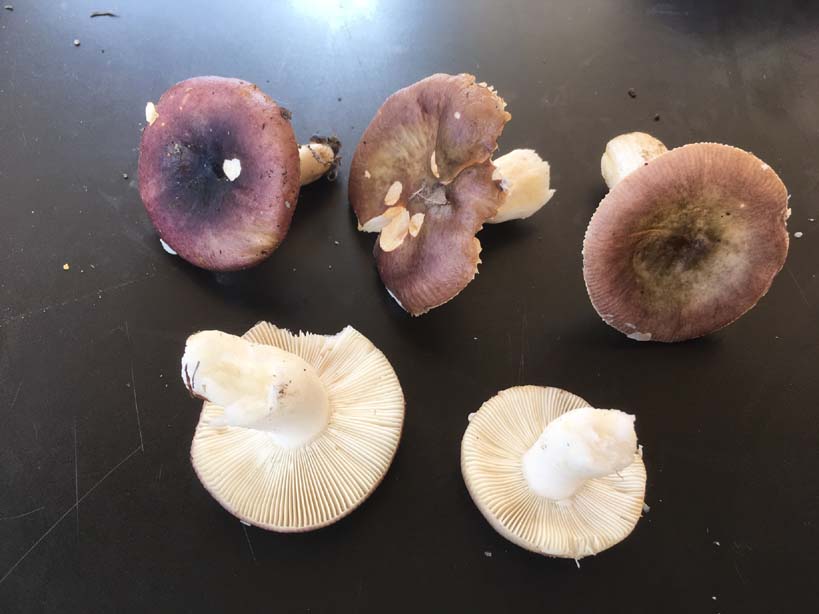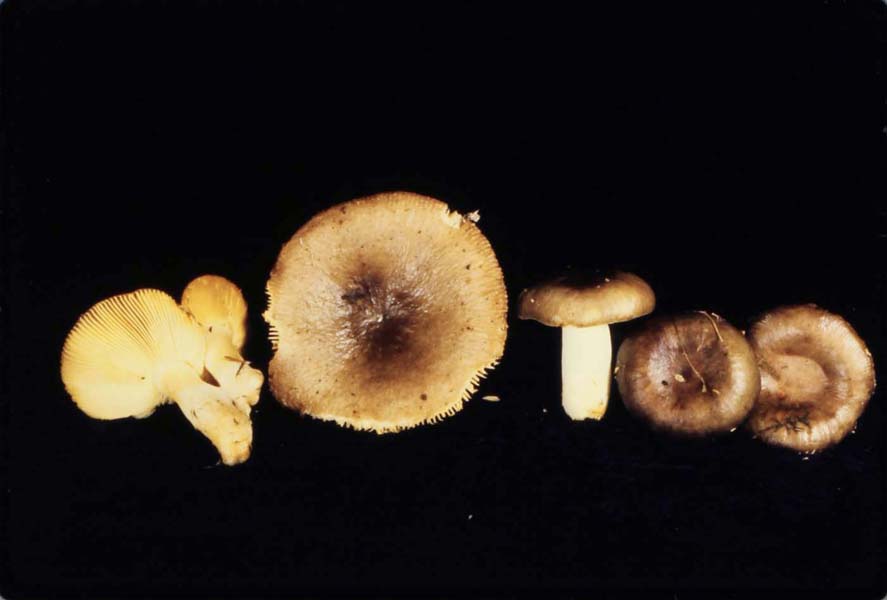

Danny’s DNA Discoveries – Russula
by Danny Miller
Clade Russula “crown” - Yellowing Russulas
Some Russula stems and other fleshy parts will turn a fairly bright yellow in age. They seem to make up a good clade of related species, although not every species in the clade may exhibit the yellowing staining very easily.
Russula versicolor group
The colours can be quite variable as the name suggests (usually with purple, red or maybe green), but carefully attention to an admittedly slight stem yellowing can help identify them. Also, this is the only yellowing species group that is acrid tasting, especially in the gills. (Both species can be acrid). What is probably the real R. versicolor, under birch, is uncommon here. Less rare is the sister species, Woo 44, usually found under cottonwoods but also under birch. Two Seattle specimens of the "sister" species were found under cottonwood instead of birch, one Seattle collection was found with birch, and one northern BC collection was found with conifers. The sister species matches some sequences labelled R. odorata, but the most reliable sequences of R. odorata are a different species, not this, so I do not believe that is what we have.
These studies confirmed that we do have the European R. versicolor here under birch trees (one specimen from WA is a single bp difference in ITS2). We also have some specimens that are 2-3 differences and 1 indel in ITS2 and a further 4 differences in ITS1 (one of those differences is variable). That could potentially mean there is a sister species, but if so, DNA matching our sister species is found all over Europe with the "real" R. versicolor as well, so the species are not distinguished by geography.
R. versicolor © Danny Miller, Russula aff versicolor sp. Woo 44 © Ben Woo
Russula sp. Woo 42 (aff puellaris, aff cremeirosea)
This is the rarest of three similar species in the yellowing clade, only found once on Washington’s Olympic peninsula near conifers (spruce, Doug fir, hemlock and cedar). Yellowing was not noted in the notes, but you can see yellowing in the photo. This group of mushrooms have previously gone under the name Russula puellaris. That similar, closely related European Russula was thought to be our local species until these studies have revealed differently. This species is about 3% different from R. puellaris, probably enough to justify it being a different species. It is also about 3% different from R. cremeirosea. This single collection had more red tones than purple tones, but it’s impossible to say what its usual colours would be.
R. sp. Woo 42 (aff puellaris) © Ben Woo
Russula ‘sapinea’
Most yellowing Russulas in the PNW are this one and the next one. This little known European Russula may not be known to turn yellow over there, but it does over here, so it should be more closely examined in Europe. The genetic variation is a bit high in sequences of this species (up to a full %), but without forming any groups, so I think it may just be all one species. It’s possible somebody will find a reason to split it into more than one species in the future. It is usually purple, but can be red-purple or closer to red like the previous species. Many different conifers were around when it has been found. Rumours of R. nauseosa being in the PNW are probably not true. I don’t even know if that European species is in the yellowing clade or in the R. zelleri group (found on the "zelleri group" page), but whatever it is, it’s not actually here.
R. sapinea © Ben Woo
Russula sp. Woo 45 (cf abietina)
This is the other common species. R. abietina was described from NY as being like R. puellaris except for not staining yellow. There is some confusion over what R. abietina really is. A study of Peck’s type collection in 1947 gave Singer the impression that it was just a mixture of the existing species R. blackfordiae and R. sphagnophila. If R. abietina truly was a new species, the Russulas that seem to be what Peck described have turned out to be one of two things. Firstly, this mushroom, that perhaps doesn’t always turn yellow in age or maybe the yellowing was not always noticed. When collected here, it’s usually noticeably yellowing. When collected in Tennessee, yellowing has mysteriously not been noted. You might expect to find the same species in New York as you do in Tennessee, so perhaps this mushroom is R. abietina. Secondly, it might be a mushroom in the Russula zelleri group (see that page). These were collected in California, I believe, which may or may not have the same species as what is found in New York. The aforementioned R. blackfordiae, R. sphagnophila and also R. brunneoviolacea are three poorly understood Russulas with dubious reports from the PNW, which this study can somewhat debunk. It is not even certain if those species belong in this clade, the R. zelleri clade, or the shrimp Russula clade. I’m going to take a guess that perhaps R. abietina is this mushroom in this yellowing clade, but all we can say for now is that it looks like it superficially, so thus my calling it “cf” abietina. To prove it, somebody will need to study the NY type, if available, and/or a number of matching collections from the New York area. Unfortunately, as far as I know, this mushroom looks identical to R. sapinea. The microscopy should be examined to see not only if this species could in fact be R. abietina, but if it can be told apart from R. sapinea and R. sp. Woo 42 (aff puellaris). This species is another conifer species.
R. sp. Woo 45 (cf abietina) © Ben Woo